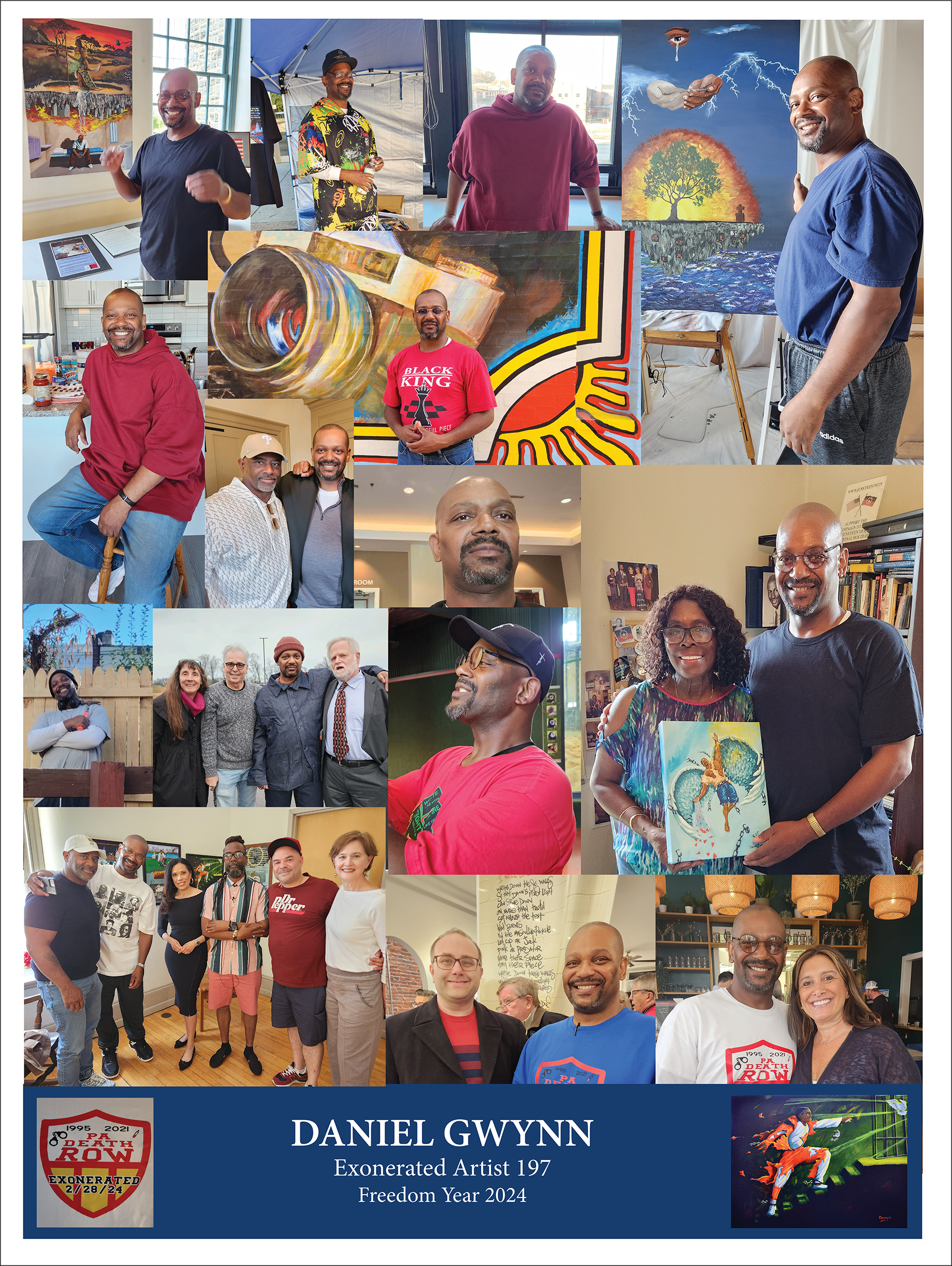
Daniel Gwynn
Exonerated Artist 197
Daniel Gwynn is a self-taught artist, motivational speaker, and advocate, whose life is a testament to his perseverance against severe injustice and to his personal transformation.
Daniel was wrongly convicted of arson and murder in 1995 and sentenced to death. After spending nearly three decades behind bars, Daniel’s death sentence was overturned in 2023, and on 2/28/24 he was exonerated and ordered to be released from prison.
While incarcerated Daniel documented his experience and declared his innocence through his art. Daniel’s art, from the abyss of death row, was his call to the world to tell of his persistent journey to obtain justice despite an avalanche of obstacles.
Since regaining his freedom Daniel has emerged as a powerful force in the art, motivational speaking and social justice world. Through his art and his advocacy Daniel is creating a lasting impact on communities as he uses his creativity as both a healing tool and a call for justice.
New Paragraph
"My Story, My Art"
by Daniel Gwynn, 2017
I am Daniel Gwynn. I am on death row in PA for a crime I did not commit. For 23 years I’ve been sitting here trapped in a box where the days just tick away, the walls closing in like a trash compactor crushing all hopes dreams and life. I paint to heal and survive. This is my art. This is my story...
I was born in Philadelphia, Pa. I was raised by my maternal grandmother. My mother had been married to an abusive man who didn’t want me in the picture. My father lived a few blocks away with the family he chose to be with.
When I was young I attended school regularly, went church, sang in the choir. It was the era of crack cocaine wars in Philadelphia. My neighborhood was ravaged with violence and drugs. The dilapidated buildings, trashy vacant lots, crack addicts and homelessness were uninspiring. As I grew, the pains of being rejected by my parents hurt me. I became a handful and my grandmother was too old to handle me.
My family situation, and the unwarranted harassment by the police, led me to rebel. I dropped out of high school and fell in with a bad crowd running the streets. I turned to drugs escape the pains of abandonment and became addicted to crack cocaine - committing petty thefts to feed my addiction. My thefts put me on the police radar. It was a time of police corruption in Philadelphia and, under the guise of “stop-‘n-frisk” the police rolled up in unmarked cars to rob us, beat us, then dump us on the other side of town. They would also compel us to sell their drugs.
As a young adult there was so much pain and anger blinding me to the beauty of life and in life. Part of the madness of the streets, I continued abusing drugs and committing petty crimes to pay for the drugs. I developed a bad reputation and was getting blamed for just about everything that happened in the hooIn 1996 I was sent to death row at SCI Greene, a prison in western Pennsylvania, five hours from Philadelphia. Connections to family and friends were already damaged by my years of addiction. We were estranged. I felt alone. I made a decision to save myself.
Part of my survival and healing took place when I began to paint. I could draw a little before coming to prison. I learned to paint in prison through self-help books given to me by Mumia Abu Jamal. Painting has been my therapy, a form of meditation that helps me work through my issues. I got good enough to enter art shows & competitions & raise money to help mentally ill prisoners and family members of murder victims. Peggy Sims, from the PA Prison Society, told me about Art for Justice (AfJ). In 2001 I began to correspond with AfJ Director – who purchased my art so I could buy art supplies and shared my art and my story with the world. She also allowed me to become a part of the fight to bring awareness to the injustice in the criminal justice system.
On death row I met Harold C. Wilson, who gave me my first law book, “The Georgetown Law Journal,” and showed me how to use the law library. Harold spent 16 years on death row in PA for a crime he did not commit. He fought his case and due to DNA evidence was found innocent. Harold was the 120th person to be exonerated from death row. He was released from death row in PA in 2005.
My transformation came about after I was forced to sit still and take a real hard look at myself. Meditation and deep contemplation helped me gain insight into my troubled life and to combat the great ills of solitary confinement. After I worked through the garbage in my head, I finally woke up and began to work on myself and my case.
On November 20, 1994 there was a fire at an abandoned apartment building – five squatters were injured and Marcia Smith died in the fire. 10 days later I found myself in the homicide interrogation room, experiencing withdraw from cocaine and being coerced by two detectives into fabricating a confession to a crime I didn’t commit.
At trial my court appointed attorney was not prepared to effectively challenge the prosecutor’s weak evidence. My attorney failed to investigate my case and failed to compel the prosecutor to produce all of its evidence. I was convicted of 1st degree murder and given the death sentence.
My conviction is based on (1) my uncorroborated coerced confession and (2) flimsy evidence that does not connect me to the crime or the victims. During the interrogation, as I was withdrawing from cocaine, the Detectives took advantage of my addled brain. They lied, manipulated information and made gestured threats to hurt me. Beaten by the police in the past, I felt their threats were real. They wanted me to regurgitate the information they were feeding me about the case into an admission of guilt.
Dr. Richard A. Leo, a national expert in police interrogations and false confessions, reviewed my case and concluded that “The confession does not contain indicia of reliability” and “does not reliably establish or corroborate guilt in this matter”. Dr. Leo also wrote in his report on my case:
- “The confession does not contain any unique, non-public crime facts that were not already known to the detective who interrogated him, and it is not independently corroborated by any physical, medical or other credible evidence.
- The confession contains crime-specific details only on those issues that the detective knew prior to interrogating Mr. Gwynn. The confession is vague on issues that the detective interrogating Mr. Gwynn did not know about.
- Mr. Gwynn’s confession narrative contains errors of fact and/or impossibilities that suggest that he was ignorant of the true crime facts and thus cast doubt on the confession’s veracity. (For example: the confession states that I ran down the steps then out the front door. The crime scene facts prove this to be impossible - because that door was cemented shut.)
- Mr. Gwynn’s interrogation was not electronically recorded. There is no objective record of what occurred and therefore no way of ruling out that Mr. Gwynn was not educated about those facts that he got correct, a phenomenon known as “contamination” that is not uncommon in police interrogations, especially those leading to false confessions.
- In my professional opinion, Mr. Gwynn’s confession is not trustworthy evidence because it contains factual errors, indications that it was not made of personal knowledge, and lacks corroboration. I do not believe that Mr. Gwynn’s confession reliably establishes or corroborates his guilt in this matter.
- There is no record of any post-confession investigation by the police to confirm any of the details in Mr. Gwynn’s statement.”
During my legal appeals we made numerous requests for evidence possessed by the Philadelphia District Attorney’s Office. These requests were denied by every State Court. They stated that I was not entitled to it, so my appeals were denied, after 15 years, my appeal to the Federal Court, granted my request for evidence. Exculpatory evidence, which the DA’s Office has known for years, has now been revealed and demonstrates the following:
- The witnesses in my case were also critical eyewitness in another murder case – the Lupton Murder trial – which took place 3 days before the fire.
- These witnesses were threatened by Lupton, the defendant, to prevent them from testifying against him.
- These witnesses testified against Lupton; three days later the building where they were living was set on fire.
- Ms. Irby, another witness from the Lupton case, reported threats and harassment by Lupton’s family and friends.
- Ms. Irby was also a victim in a similar arson in another building after her testimony at Lupton’s trial.
- Mr. Witherspoon, an informant, reported that Lupton offered him money to stop Ms. Irby from testifying. Witherspoon was provided an address where she could be found.
How I became a suspect in the case is still a mystery. The DA’s evidence revealed:
- There is no record of the victims directing the police to me as a suspect.
- The photo arrays in the Lupton case, which the prosecutor at trial claimed did not exist, were in the DA’s evidence, and I was not in these photo arrays.
- The arson case photo line-up was very suggestive, as my photo was the only one it.
Painting has enriched my life - I’ve been blessed to able to use my art to work through my pains and accomplish great things to help others. Where I once thought that all hope was lost, I’ve been able to open my heart to a variety of good people who had the courage and compassion to take a chance on me. I don’t believe I could have survived this situation on my own. I am so grateful for my friends, my surrogate family. They have embraced me and supported my fight for justice. Together, as a family, we fight for my freedom.

